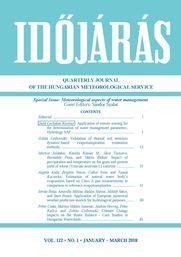IDŐJÁRÁS - angol nyelvű folyóirat
Vol. 122, No. 1 * Pages 1–99 * Januar - March 2018
 |
Special Issue: Meteorological aspects of water management |
 letöltés [pdf: 2680 KB]
letöltés [pdf: 2680 KB]
Validation of diurnal soil moisture dynamic-based evapotranspiration estimation methods
Zoltán Gribovszki
DOI:10.28974/idojaras.2018.1.2 (p. 15–)
Zoltán Gribovszki
DOI:10.28974/idojaras.2018.1.2 (p. 15–)
IDŐJÁRÁS folyóirat

Az IDŐJÁRÁS a HungaroMet Nonprofit Zrt. negyedévenként megjelenő angol nyelvű folyóirata
Megrendelhető a journal.idojaras@met.hu címen.
A szerzőknek szánt útmutató itt olvasható.
Megrendelhető a journal.idojaras@met.hu címen.
A szerzőknek szánt útmutató itt olvasható.









